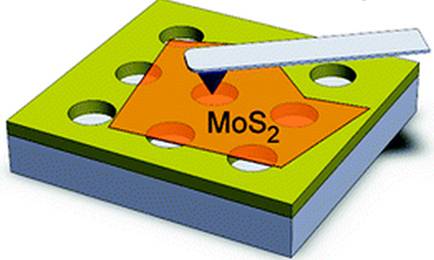First Molybdenite microchip
December 5, 2011

Stiffness tests of monolayer molybdenum disulfide membranes using an atomic force microscope probe show that the material is ideal for fabrication of flexible electronic devices (credit: Simone Bertolazzi/ EPFL/ACS Nano)
École Polytechnique Fédérale de Lausanne (EPFL) Laboratory of Nanoscale Electronics and Structures (LANES) scientists have made the first molybdenite microchip, using smaller and more energy efficient transistors. Molybdenite, a new and very promising material, can surpass the physical limits of silicon in terms of miniaturization, electricity consumption, and mechanical flexibility, the scientists say.
“We have built an initial prototype, putting from two to six serial transistors in place, and shown that basic binary logic operations were possible, which proves that we can make a larger chip,” said LANES director Andras Kis.
In early 2011, the lab unveiled the potential of molybdenum disulfide (MoS2), a relatively abundant, naturally occurring mineral. Its structure and semi-conducting properties make it an ideal material for use in transistors, allowing it to compete directly with silicon, the most highly used component in electronics; and on several points it also rivals graphene, Kis said.
Chip layers three atoms thick
“The main advantage of MoS2 is that it allows us to reduce the size of transistors, and thus to further miniaturize them,” explained Kis. “It has not been possible up to this point to make layers of silicon less than two nanometers thick, because of the risk of initiating a chemical reaction that would oxidize the surface and compromise its electronic properties. Molybdenite, on the other hand, can be worked in layers only three atoms thick, making it possible to build chips that are at least three times smaller. At this scale, the material is still very stable and conduction is easy to control.
MoS2 transistors are also more efficient, he said. “They can be turned on and off much more quickly, and can be put into a more complete standby mode. Molybdenite is on a par with silicon in terms of its ability to amplify electronic signals, with an output signal that is four times stronger than the incoming signal. This proves that there is “considerable potential for creating more complex chips. With graphene, for example, this amplitude is about 1. Below this threshold, the output voltage would not be sufficient to feed a second, similar chip.”
Molybdenite also has mechanical properties that make it interesting as a possible material for use in flexible electronics. These could, for example, be used to manufacture computers that could be rolled up, or devices that could be affixed to the skin.
Ref.: Branimir Radisavljevic et.at., Integrated Circuits and Logic Operations Based on Single-Layer MoS2, ACS Nano, 2011 [DOI: 10.1021/nn203715c]
Ref.: Simone Bertolazzi et al., Stretching and Breaking of Ultrathin MoS2, ACS Nano, 2011 [DOI: 10.1021/nn203879f]